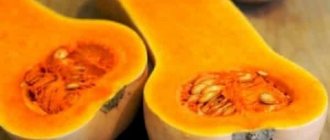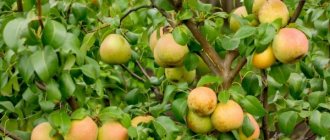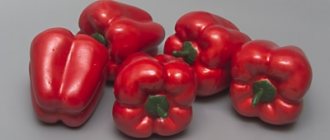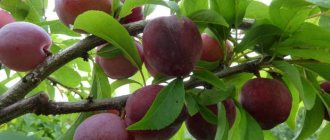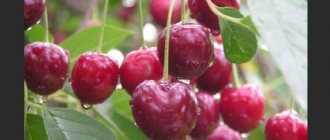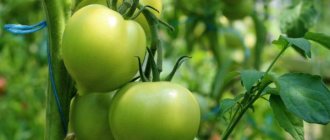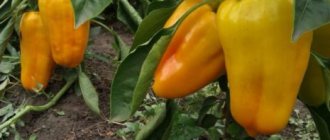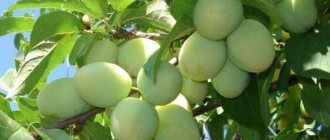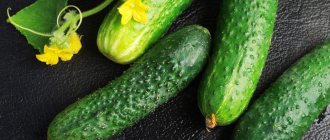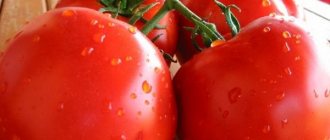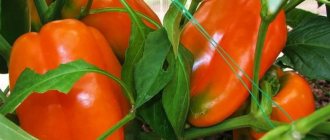Vegetable growing » Pumpkin
0
654
Article rating
Kira Stoletova
Rossiyanka pumpkin is a new variety bred by Russian breeders. The fruits are sweet, large, their weight reaches 60 kg. They are stored for a long time without changing their taste. The variety has a rich composition, which includes a huge amount of vitamins, microelements and nutrients.
Characteristics and rules for growing Russian pumpkin
Description of the variety
The variety is recommended for cultivation in central Russia and the Moscow region. The vegetable is cultivated in greenhouses and open beds; the ripening period is 90-100 days. It does not require special care, so it is great for beginner gardeners.
Distinctive features
The bushes are compact, semi-spreading. The leaf blade is wide, the lashes are of medium length. During the ripening process, many additional shoots are formed that must be removed. The variety rarely gets sick and is resistant to insect pests. The best yield is shown on loose and nutritious soils.
Fruit characteristics and yield
The pumpkins are small, the weight of one varies from 2 to 4 kg. The pulp is dense, sweet, with a melon aroma. The surface is smooth, the color is orange. The taste and product qualities are excellent; the Rossianka variety is universal in use. From 1 sq. m, gardeners collect about 6 kg of delicious and beautiful fruits.
Interesting! Pumpkin is 90% water and contains beta-carotene, which is beneficial for human health. This powerful antioxidant neutralizes the negative effects of free radicals and protects the body from premature aging.
Planting and growing
Since the culture belongs to non-capricious plants, pumpkin of this variety requires compliance with certain rules and agrotechnical techniques for its successful cultivation.
Soil and crop rotation requirements
Pumpkin does not have any special requirements for soil quality, but it develops most successfully on sandy loams and loams.
It is useful if these areas were occupied before:
- cabbage;
- potatoes;
- legumes;
- root vegetables;
- onions
Pumpkin shows the worst yield if its predecessors were presented:
- zucchini;
- squash;
- cucumbers;
- watermelons;
- melons.
Suitable conditions
The optimal temperature at which this plant feels most comfortable lies between +22°C and +28°C. Pumpkin also loves bright light, so sunny areas are chosen for planting, which should also be protected from strong winds. The best places for this are the southern sides of houses, barns or fences, where pumpkin vines can climb.
The ideal place to plant this plant is a south-facing compost heap, near which the pumpkin feels great, directing its vines to the mountain of compost. At the same time, pumpkin does not like high air humidity (which cannot be said about the soil, which should be watered abundantly at least once a week).
Soil and seed preparation
The best quality soil preparation for planting pumpkins is that which is done in the fall after harvesting the predecessors.
The cleared area is fertilized:
- 5 kg of humus;
- 15 g sodium chloride;
- 30 g superphosphate.
This amount of fertilizer is optimal for each square meter of territory, which is then dug up 0.2 m deep. If it is necessary to make the soil loose, river sand and peat are added to it, and if it is necessary to deoxidize the soil, then it should be sprinkled with wood ash, loosened and watered with heated water.
After such autumn treatment, there is no need to dig up the soil in the spring. It just needs to be cleared of weeds, loosened with a rake and left in this state until May, when it’s time for planting.
Preparing seeds for sowing involves germinating them, which is carried out as follows:
- Pumpkin seeds are placed in water at a temperature from +40° C to +50° C for 3 hours.
- The swollen seeds are wrapped in damp cotton cloth or gauze and, while constantly maintaining the cloth's moisture, are left at room temperature until hatching.
- To strengthen their cold resistance, it is recommended to keep the sprouted seeds for 5 days, without removing them from a damp cloth, in the lower compartment of the refrigerator.
Planting seeds
Depending on the geographic location, the seeds are either immediately planted in the ground, or seedlings are first grown from them, which are then transferred to open ground.
In open ground
Typically, when sowing, no more than 2 seeds are placed in holes located at a distance of no closer than 0.75 m from each other to a depth of maximum 5 cm. The crops should then be watered.
In pots for seedlings
In regions where there is a danger of frost in the spring, which the “Russian woman” cannot tolerate, to be on the safe side, the sprouted seeds are not sown immediately in open ground, but seedlings are first grown from them.
For this:
- Peat pots or tablets are used, as well as cardboard cups with a diameter of 0.1 m. These containers allow you to plant seedlings in the ground without disturbing the pumpkin roots, which are extremely painful to transplant.
- If there is no professionally prepared purchased soil, prepare the soil for seedlings on your own by mixing river sand and peat (or turf soil and humus) in equal proportions in a ratio of 1:4.
- After watering, 2 seeds are placed in the soil to a depth of 2 cm.
- The containers are covered with glass or transparent film and kept at a temperature of + 25°C until sprouts appear.
- Of the two sprouts, choose the strongest one, and pinch the second one.
- The temperature is lowered to +20°C and the seedlings are placed in a bright place, watering the soil as its top layer dries.
- After 25-27 days, the seedlings are planted in a permanent place.
How to grow
Vegetables are planted in several ways. Let's consider each of them in detail, identifying distinctive features and features.
Planting seeds in open ground
This method is suitable for growing vegetables in the southern regions of the country with favorable climatic conditions. First of all, prepare the seeds themselves. The material is etched by heating at a temperature of +65° C for 2-3 hours. After which the seeds are hardened at a temperature of +1 °C for 24 hours. Hardening strengthens the plant's immunity and accelerates adaptation to weather conditions.
Next, it is recommended to wash the seeds with Formalin and running water. Only after all procedures is the material ready for planting.
Important! Pay attention to preparing the beds. Pumpkins should not be planted after cucumbers or zucchini; it is better to give preference to beds of greens or cabbage. A warm area with a deep arable layer and loose soil is allocated for the crop.
The crop loves cleaned beds, which experienced gardeners take care of in advance. Weeds are removed from the beds and dug up to a depth of 30 cm. To ensure that the soil retains moisture, it is mixed with light loamy soil and dry sawdust is added.
For reliability, the mineral vermiculite is added to the soil. It saturates the soil with beneficial properties, which has a beneficial effect on the future harvest. Seeds are planted according to a 1 x 1.5 m pattern. 3-5 seeds are placed in pre-prepared holes at a time. Sprinkle the top with soil and peat chips.
Planting seedlings
Seedlings require soil and a container.
As seedling soil, disinfected soil from the garden or ready-made compounds are used. Experienced summer residents recommend disinfection in any case to avoid fungi and infections. Peat or humus will help increase the germination of seedlings. Plant seedlings in any container, the main thing is that it is clean and dry. Most often, peat tablets and pots, plastic cassettes with pallets, and boxes are used as containers. Soil is poured into the container, watered abundantly and holes 1-1.5 cm deep are made. The seeds are placed in the ground, sprinkled with earth and watered again.
For normal development of seedlings, it is necessary to moisten the seedlings once a week. It is important to avoid excess water - excessive humidity increases the risk of developing diseases.
To accelerate growth, succinic acid or the stimulant Heteroauxin are added to the seedlings. The products increase seed germination by 10-20% and develop increased immunity. Feed the pumpkin several times. For the first feeding, organic liquid fertilizers, such as bird droppings, are used. The second time it is recommended to add mineral components.
Care
Water the beds using a watering can or hose. When using a watering can, be sure to put on a special nozzle, and when using a hose, clamp the stream so that the water is distributed evenly. It is recommended to water the pumpkin not at the root, but in a special groove near the bush. This technique will help not wash the roots and keep the young stems safe and sound. Before watering, loosen the soil by 10-15 cm. Moisten the soil in the morning or evening to avoid sunburn.
Feeding plays a special role. After planting on the site, the plant is fed after 15 days. Vermicompost, compost, humus, ash, and liquid manure are recognized as excellent top dressing. Organic fertilizers reduce soil acidity and improve microflora. 2-3 liters of fertilizer are used for 1 bush.
As for mineral fertilizers, summer residents prefer to feed plants with superphosphate or potassium salt, as well as complex mineral preparations, such as “Magic Watering Can”, “Juno”, “Garden Mix”. They are easy to use and promote healthy pumpkin development.
Important! Do not apply fertilizers to dry soil; plants may get burned. Before the procedure, the beds must be watered.
Features of cultivation and possible difficulties
A month after planting in the garden, they begin to form a bush. As soon as 1-2 fruits form on the main stem, it is pinched. In this case, the length of the lateral processes should be no more than 50-60 cm in order for ovaries to form on them. If this is not done in time, then many small fruits appear on the bushes, which do not have time to ripen due to a limited supply of food. During the formation of the bush, watering is reduced.
Experienced farmers always monitor what mineral fertilizers they apply and in what quantities. For example, ammonium nitrate and calcium nitrate contain nitrogen, an excess of which can lead to fruit wilting. Therefore, it is not recommended to apply these fertilizers together. Summer residents advise alternating organic and mineral nutrition with each other in order to maintain proper metabolism.
Growing tips from experienced gardeners
To avoid problems with growing, gardeners recommend following basic agrotechnical rules: water and fertilize the beds on time, apply fertilizers in a timely manner and loosen the soil.
In addition, vegetable growers share their secrets of a rich harvest:
- lime the soil to reduce its acidity and make it more nutritious;
- germinate seeds before planting seedlings;
- plant crops on hilly beds;
- plant a pumpkin in a plot on a windless, cloudy day;
- for irrigation, use water at a temperature not lower than +20 °C;
- periodically spray the bushes with a whey solution;
- unravel the lashes and sprinkle them with earth.
Diseases and pests
Diseases usually appear at the stage of fruit formation. The reasons for their appearance lie in contaminated soil, improper care, heat and high humidity.
The most common diseases found in pumpkin patches are:
- Root rot occurs in rainy and hot summers. The roots become covered with plaque, which is why the bush soon dies. For prevention purposes, use a solution of copper sulfate or ash.
- Tobacco mosaic appears as a yellow pattern on the leaves. Bushes become infected from weeds, debris, and remnants of last year's plants. Bordeaux mixture or the drug “Fundazol” helps fight mosaic.
- Bacteriosis. The infection can be transmitted by insects and birds; if infected, bacteriosis instantly spreads throughout the garden. The leaves become stained and the fruits lose their elasticity. The disease is treated with copper oxychloride (the drug “HOM”).
Among the pests, the whitefly loves to feast on plants. The small white midge lives in flocks, gathers on leaf blades and sucks the juice from them, without which the bushes die. Another pest is the spider mite. The bug envelops the plant with its web, causing the plant to dry out. Sprays based on iodine and milk, as well as the preparations Provotox and Oxychom, help fight pests.
Caring for Russian pumpkin
Calabash
Includes several points:
- water;
- weed, loosen;
- feed.
Regularly watering the plant is the most important thing in caring for this vegetable, since the leaves are large and so is the evaporation area. One square meter requires 3.5 - 4 buckets of water. It is necessary to water at least twice in 7 days with settled warm water.
Watering
The first feeding of the pumpkin is carried out after the appearance of the sixth leaf. The second time is fed when the plant has begun to grow vigorously. And then it is recommended to feed once every half month. At the same time, alternate mineral supplements and organic ones. When the fruits begin to ripen, it is necessary to feed the plant bush with ash.
In a word, growing and caring for Russian pumpkin is no different from cultivating other varieties.
Harvesting and application
Harvest with the arrival of autumn. The fruits acquire a bright color, the crust becomes hard. The vegetables are picked together with the stalk, wiped with a napkin and stored. Gardeners advise eating fruits with scratches and cracks as soon as possible.
The vegetable is used to make tasty and healthy porridge, puree soup, compotes and jam. The product is consumed boiled, baked and fried. Part of the pumpkin is frozen in the freezer, after cutting it into small cubes.
Prepare a face mask based on pumpkin and honey. Nicotinic acid in the mixture relieves puffiness and returns a healthy color to the skin, and vitamin E accelerates the production of collagen, which is responsible for skin elasticity.
Pumpkin stores well in a cool place, so it can be used at any time of the year. In addition to masks, it is used to make refreshing compresses and nourishing lotions.
Russian pumpkin: description/characteristics, or a true beauty in your garden
How is everyone used to seeing pumpkins? Huge, overwhelming, often stiff and even cracked by the end of the season. The new variety of Russian breeders (VNIIssok) is the complete opposite of the old varieties, one that amazes with its yield, uniformity of fruits and ease of cultivation.
A striking advantage of the variety is the ability to grow in a small area, as well as vertical cultivation on a trellis. All this is possible thanks to:
- average growth of lashes;
- fetal weight 1.9-4.1 kg;
- easy to care for and undemanding to the soil.
Russian pumpkin fruits
However, this is not all the advantages of the variety. These include early ripeness (100-110 days pass from germination to technical maturity of the fruit), cold resistance, because the variety was developed for the Central region, yield - 22-25 kg per plant.
At the same time, the fruit itself will delight you with its tenderness, sugar content, crumbly pulp, the thickness of which is 2-8 cm. The pumpkin itself has the shape of a turban, the skin is perfectly smooth, the color is red orange. A striking feature, uncharacteristic of other varieties, is the taste of melon. Thanks to excellent storage, pumpkin can be eaten until the next season, using it in your favorite dishes and in dietary meals.
Advantages and disadvantages of the variety
The Russian variety has a lot of advantages and useful properties, but gardeners also note a couple of disadvantages.
The advantages of Russian pumpkin are:
- high and stable yield;
- high taste and commercial qualities;
- immunity to diseases and pests;
- long shelf life;
- useful composition.
Among the disadvantages, they note the fact that the variety is demanding on the composition of the soil; the best harvest grows in fertile and nutritious soil. The plant also requires increased attention, as it needs timely formation of the bush and fertilizing.
Farmer reviews
It’s interesting to know what others think about Russian pumpkins. Here are reviews from experienced gardeners.
Ilya, Cheboksary: “I’ve never grown pumpkin before, so I decided to start with the Rossianka variety. The harvest turned out good, the fruits grew beautiful and even. The taste is excellent, the whole family liked it.”
Alisa, Orenburg: “Rossiyanka is one of my favorite early varieties. Caring for vegetables is a pleasure; they are unpretentious. The returns are excellent, I start harvesting at the end of August.”
Mikhail, Voronezh: “The summer turned out to be rainy, so the pumpkin got root rot. We managed to cure it, but lost half the harvest. Next time I will choose varieties that are more disease-resistant.”
